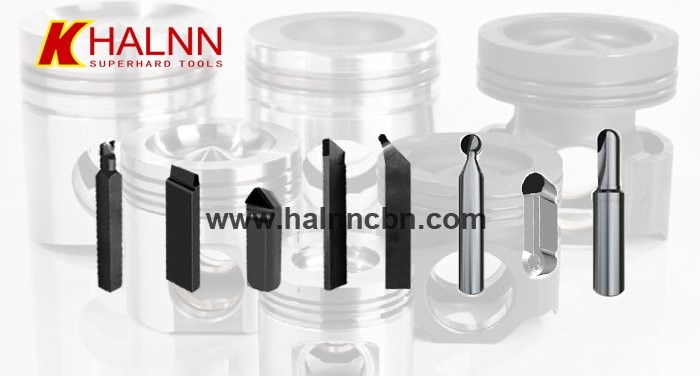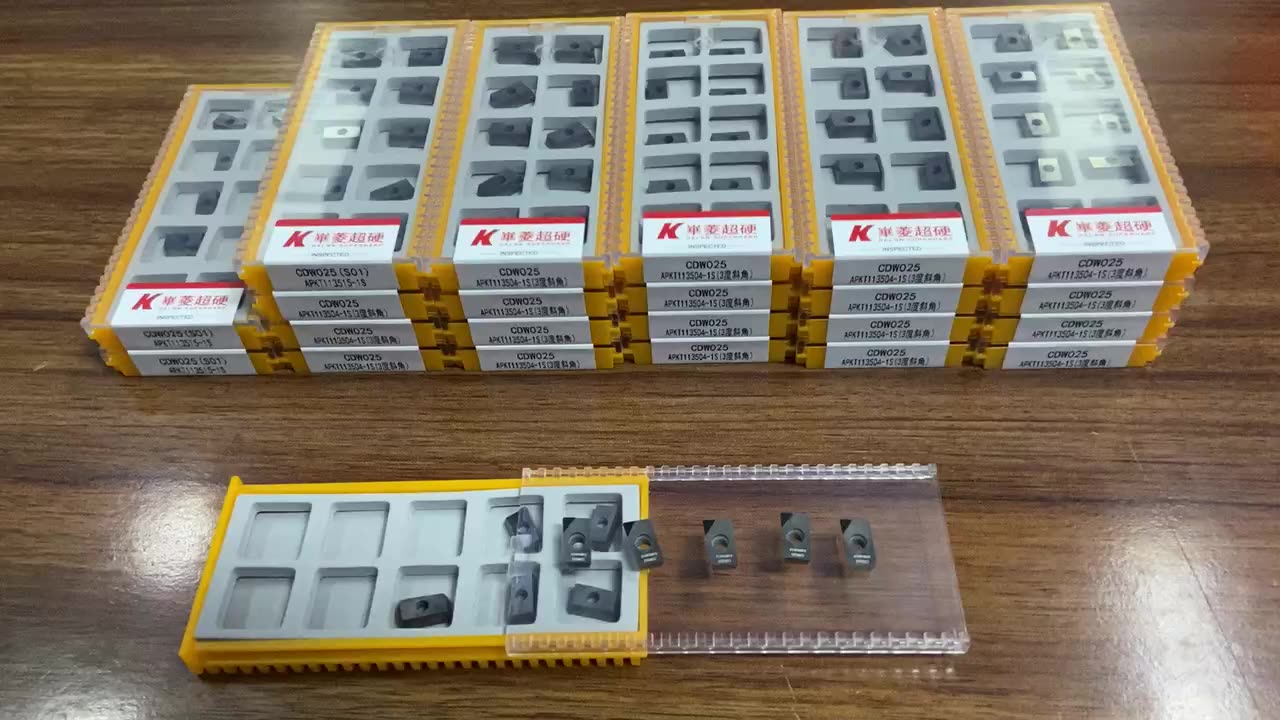Piston manufacturing is a critical component of the automotive and aerospace industries, where precision and durability are paramount. The machining tools used in this process play a vital role in ensuring the quality and performance of pistons. Among these tools, PCD (Polycrystalline Diamond) inserts stand out for their exceptional properties. This article explores the significance of piston PCD inserts in piston manufacturing, their advantages, applications, and how Halnn Group is leading the way in providing cutting-edge solutions.
PCD cutting inserts are cutting tools made from Polycrystalline Diamond, a synthetic diamond material known for its extreme hardness and wear resistance. These inserts are created by sintering diamond particles at high pressures and temperatures, resulting in a tool that combines the hardness of diamond with a robust cutting edge. PCD cutting inserts are particularly effective for machining non-ferrous materials such as aluminum alloys, commonly used in pistons.
Compared to other inserts like carbide or CBN cutting inserts, PCD cutting inserts offer superior performance in terms of longevity and precision, making them ideal for high-precision piston manufacturing.

In piston manufacturing, the need for high precision and superior surface finish cannot be overstated. piston PCD inserts excel in these areas, ensuring that each piston meets stringent quality standards. The accuracy provided by piston PCD inserts helps in achieving the desired dimensions and surface smoothness, which are crucial for the optimal performance and efficiency of pistons.
The use of PCD cutting inserts in various machining operations such as turning, grooving, and milling ensures that pistons are manufactured to the highest standards, contributing to the overall reliability and longevity of engines.
PCD cutting inserts are incredibly hard, making them resistant to wear and capable of maintaining a sharp cutting edge for longer periods. This durability reduces the frequency of tool changes, leading to increased productivity and lower manufacturing costs.
The exceptional sharpness of piston PCD inserts results in a superior surface finish, which is critical for the performance of pistons. Smooth surfaces reduce friction and wear, enhancing the efficiency and lifespan of the piston.
The wear resistance of piston PCD inserts translates to a significantly longer tool life compared to other materials. This longevity not only reduces tooling costs but also minimizes downtime for tool changes, further enhancing productivity.
PCD cutting inserts are particularly effective for machining aluminum alloys, a common material for pistons. They provide clean cuts and prevent issues such as built-up edge,which can compromise the quality of the machined part.

PCD turning inserts are used for precise turning operations, ensuring that the piston dimensions are accurate and the surface finish is smooth.
PCD grooving inserts are designed to create precise grooves in pistons, which are essential for accommodating rings and other components. These inserts provide high accuracy and repeatability.
PCD milling inserts are used for complex milling operations, offering high precision and excellent surface quality. They are ideal for finishing operations that require tight tolerances and smooth surfaces.
PCD cutting inserts are used in various machining processes, including turning, grooving, and milling. Each process requires specific techniques and parameters to achieve the best results.
Tool Setup: Ensure that the tool is properly secured and aligned to prevent vibrations and inaccuracies.
Cutting Parameters: Optimize cutting speed, feed rate, and depth of cut to balance material removal rates and tool wear.
Cooling and Lubrication: Use appropriate cooling and lubrication strategies to manage heat and prevent tool damage.
Cutting Speed: Higher cutting speeds can improve surface finish but may increase tool wear. Finding the optimal speed is key.
Feed Rate: Adjust the feed rate to achieve the desired surface finish and dimensional accuracy.
Depth of Cut: Use appropriate depths of cut to minimize tool stress and achieve precise machining.
Tool Wear and Chipping: Despite their hardness, PCD cutting inserts can chip if not used correctly.
Heat Management: High-speed machining generates heat, which can affect the tool and workpiece.
Vibration: Ensuring stable machining conditions is crucial to prevent vibrations that can lead to inaccuracies.
Advanced Tool Materials: Use piston PCD inserts specifically designed for high-stress applications.
Optimized Cutting Parameters: Carefully balance speed, feed, and depth to minimize wear and maximize tool life.
Stable Machining Conditions: Ensure that the machine setup is stable and free from vibrations.

Quality control is essential in piston manufacturing. Precision measurement tools such as coordinate measuring machines (CMM) and optical systems are used to verify the dimensions and surface quality of machined pistons.
Non-destructive testing (NDT) techniques such as ultrasonic and radiographic testing are employed to detect internal defects without damaging the pistons. These tests ensure that the pistons meet all quality standards and perform reliably in their intended applications.
Innovations in piston PCD insert technology continue to drive advancements in piston manufacturing. New developments focus on enhancing the durability and precision of inserts, enabling more efficient and high-quality machining processes.
Automation and robotics are becoming increasingly important in piston manufacturing. These technologies enhance consistency, reduce labor costs, and increase production speed, ensuring that high-quality standards are maintained.
Digital twin technology allows manufacturers to simulate the machining process, optimizing parameters and predicting outcomes before actual production. This reduces trial and error, saving time and resources.
Efficient drilling and machining practices contribute to sustainability by reducing energy consumption and material waste. PCD cutting inserts, with their longer tool life and precision, support these practices by minimizing the need for frequent tool changes and rework.
Halnn Group is committed to promoting sustainable manufacturing through the development of eco-friendly tools and processes. Our innovations in tool design and machining techniques aim to reduce environmental impact while enhancing productivity and quality.
Halnn Group has partnered with several leading manufacturers to implement advanced PCD insert solutions. These case studies highlight significant improvements in production efficiency, tool life, and product quality. For example, a major automotive manufacturer reported a 30% increase in production speed and a 20% reduction in material waste after adopting Halnn Group’s PCD cutting inserts.
Clients have praised Halnn Group for providing reliable and high-performance piston PCD inserts that have significantly enhanced their manufacturing processes. Testimonials emphasize the benefits of using Halnn Group’s solutions, including improved precision, reduced costs, and increased productivity.

PCD cutting inserts are a critical component in the high-precision, efficient manufacturing of pistons. Their superior hardness, wear resistance, and precision make them ideal for achieving the high standards required in the automotive and aerospace industries. Halnn Group is at the forefront of innovation in this field, providing advanced machining tools and solutions that drive the future of piston manufacturing. Our commitment to quality, sustainability, and customer satisfaction ensures that we remain a trusted partner for manufacturers worldwide.
Halnn Group is a leader in the development and supply of advanced machining tools, specializing in PCD cutting inserts for high-precision applications. With a commitment to innovation and excellence, Halnn Group offers a comprehensive range of products designed to meet the demanding needs of the piston manufacturing industry. Our expertise and dedication to customer satisfaction have made us a trusted partner for manufacturers around the globe. For more information, visit Halnn Group's official website: halnncbn.
PCD (Polycrystalline Diamond) inserts are cutting tools made from synthetic diamond materials. These inserts are known for their extreme hardness, wear resistance, and ability to maintain a sharp cutting edge, making them ideal for high-precision machining of non-ferrous materials such as aluminum alloys used in pistons.
PCD cutting inserts are preferred for piston manufacturing due to their superior hardness and wear resistance, which result in a longer tool life and reduced tool changes. They also provide a high-quality surface finish and maintain dimensional accuracy, both critical for the efficient performance and longevity of pistons.
Compared to carbide and CBN (Cubic Boron Nitride) inserts, PCD cutting inserts offer superior wear resistance and tool life, especially when machining non-ferrous materials. They also provide a better surface finish and higher precision, making them the preferred choice for applications requiring high-quality machining.
PCD cutting inserts used for piston machining include turning inserts, grooving inserts, and milling inserts. Each type is designed to perform specific machining operations, such as precise turning for dimensional accuracy, grooving for creating piston rings, and milling for complex shapes.
The advantages of using piston PCD inserts include:
High hardness and wear resistance: Ensures longer tool life and reduced frequency of tool changes.
Superior surface finish: Achieves smoother surfaces, reducing friction and wear on the piston.
Dimensional accuracy: Maintains precise tolerances, essential for the performance and efficiency of pistons.
Enhanced performance: Particularly effective for machining non-ferrous materials like aluminum alloys.
Common challenges include:
Tool wear and chipping: Despite their hardness, improper use can lead to chipping.
Heat management: High-speed machining generates heat, which can affect both the tool and the workpiece.
Vibration: Ensuring stable machining conditions is crucial to prevent inaccuracies.
Tool wear can be minimized by:
Using high-quality PCD cutting inserts: Ensuring the inserts are designed for high-stress applications.
Optimizing cutting parameters: Balancing speed, feed rate, and depth of cut to reduce stress on the tool.
Proper cooling and lubrication: Implementing appropriate cooling and lubrication strategies to manage heat.
Cooling and lubrication are essential to:
Prevent overheating: Reducing the risk of thermal damage to both the tool and the workpiece.
Improve cutting performance: Enhancing the efficiency and quality of the machining process.
Extend tool life: Minimizing wear and tear on the inserts.
The quality of PCD cutting inserts is ensured through:
Precision manufacturing: Using advanced technologies and stringent quality control measures.
Testing procedures: Employing methods like coordinate measuring machines (CMM) and optical measurement systems to verify dimensional accuracy and surface finish.
Non-destructive testing (NDT): Techniques such as ultrasonic and radiographic testing to detect internal defects.
Future trends include:
Advanced materials and coatings: Developing new PCD compositions and coatings to enhance performance and durability.
Automation and robotics: Increasing use of automated systems to improve consistency and efficiency in machining.
Digital twin and simulation technologies: Utilizing simulations to optimize machining processes and predict outcomes before actual production.
Halnn Group is at the forefront of innovation in PCD insert technology, offering high-quality machining tools designed for high-precision applications. The company focuses on developing durable, efficient, and eco-friendly tools, optimizing machining processes, and investing in research and development to drive advancements in the industry.
WhatsApp:8613271562251
Email:service@halnn-group.com
Address:R & D 5B, National University Science and Technology Park, National University, Changchun Road, Zhengzhou High-tech Zone